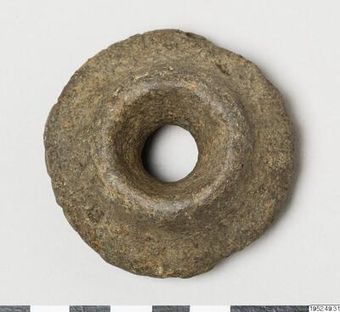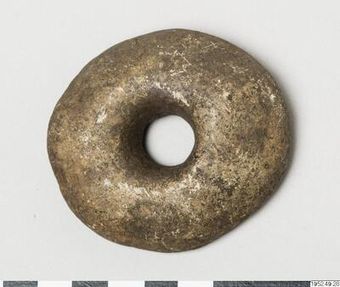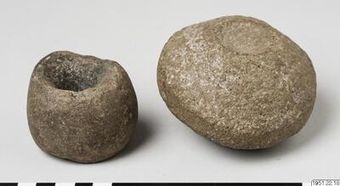Connect with Horniman Museum and Gardens
Contact this content partner to get more information about this item.
club
- Description:
- Chiefly Club, Kinikini, Fiji, Western Polynesia Very broad, paddle-shaped clubs such as this kinikini were made only in Fiji, and in Tonga for a short period around the turn of the 19th Century. They required an enormous amount of effort to manufacture, as they were cut from a single block of hardwood, usually nokonoko (Casuarina equisetifolia, the Ironwood). This is a small, squat tree, and so an entire trunk might only supply planks suitable for carving one or two kinikini. This was never a very common club style, but their cultural importance was high: they acted as the insignia of chiefly men in several parts of eastern and southern Fiji, and were forbidden to commoners. Their function in this role was more than symbolic, however: on the battlefield, the kinikini served as both an easily visible standard for the chief’s forces, and as a shield against the volley of arrows and throwing clubs that flew as the opposing bodies of men closed for hand-to-hand combat. Like some club styles from other parts of the Pacific, kinikini often bear a pair of eye-like motifs engraved on each face (sometimes more than one). This expresses the fact that clubs were understood to become named, supernatural beings once they had distinguished themselves by killing in battle. Some clubs became the paths by which the gods or dead ancestors possessed traditional priests (bete) during religious rituals, or left their bodies afterwards. Kinikini became particularly associated with this role, and were therefore not only shields and standards on the battlefield, but also portable god-vessels. Wood. Mid-19th century. Provenance unknown. Large kite-bladed paddle club of Clunie type 7E, decorated on the upper half with a pattern of cross hatched diamonds surrounding a inverted V of serrated piping and two eye motifs of concentric circles and radiating lines. This type was carried by chiefs and priests as insignia of their office.
- Format:
- image
- Collections:
- Horniman Museum and Gardens
- Content partner:
- Horniman Museum and Gardens
- Availability:
- Not specified
-
Copyright status: All rights reservedFind out more about what you are able to do with this itemThis item is all rights reserved, with means you'll have to get permission from Horniman Museum and Gardens before using it. For more information, please see our use and reuse page.More informationHorniman Museum and Gardens has this to say about the rights status of this item:
http://rightsstatements.org/vocab/InC/1.0/
What can I do with this item?Non-infringing useNZ copyright law does not prevent every use of a copyright work, and this item may be hosted by an international institute or organisation. You should consider what you can and cannot do with a copyright work.No sharingYou may not copy and/or share this item with others without further permission. This includes posting it on your blog, using it in a presentation, or any other public use.No modifyingYou are not allowed to adapt or remix this item into any other works.No commercial useYou may not use this item commercially.
Welcome and warm Pasifik greetings
The information on this site has been gathered from our content partners.
The names, terms, and labels that we present on the site may contain images or voices of deceased persons and may also reflect the bias, norms, and perspective of the period of time in which they were created. We accept that these may not be appropriate today.
If you have any concerns or questions about an item, please contact us.



